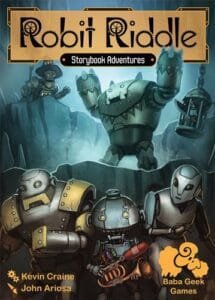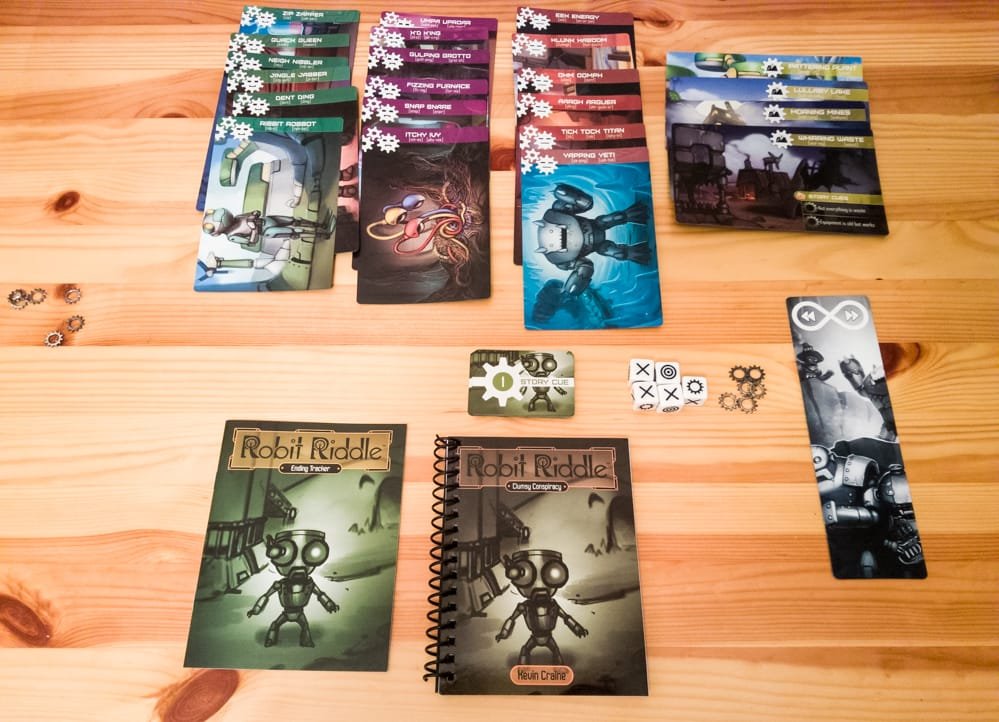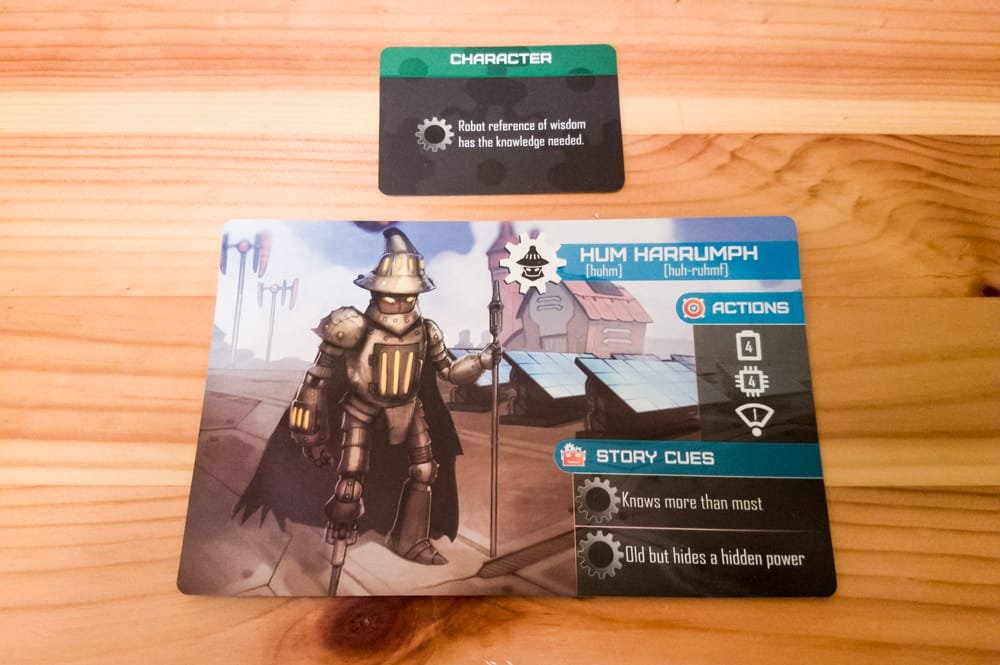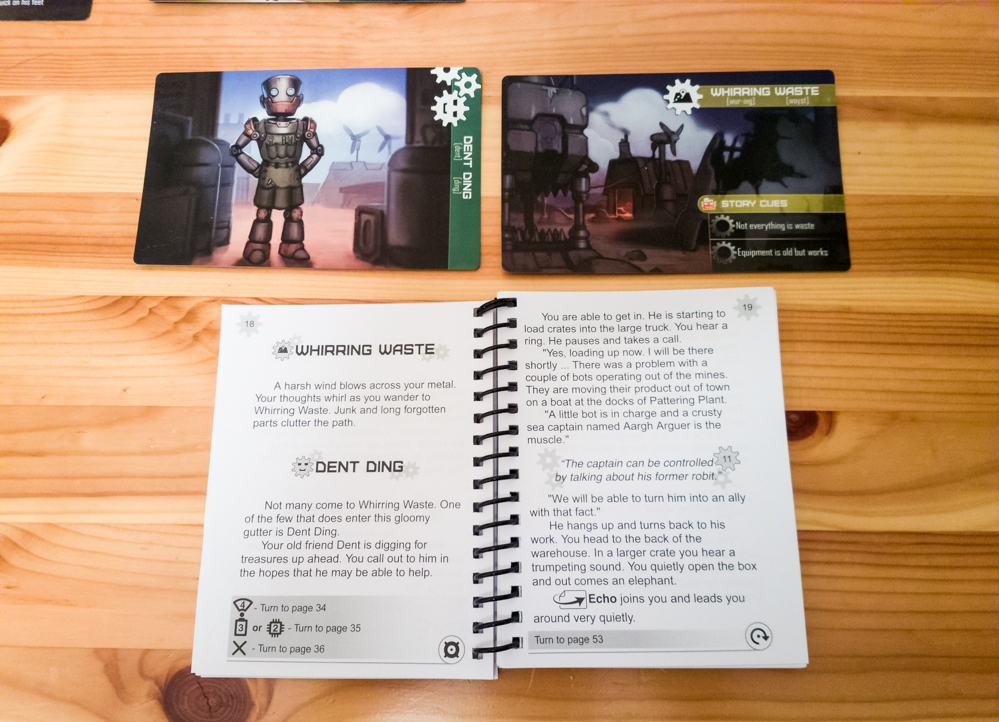Robit Riddle: Storybook Adventures Review
Year: 2018 | Players: 1-6 | Minutes: 5-45 | Ages: 8+
This Robit Riddle: Storybook Adventures review was made after playing the game seven times.
What is Robit Riddle?
Robit Riddle: Storybook Adventures is a cooperative storytelling board game in which you play as robots attempting to find out what happened to your pet robits. You’ll travel around Tink Town trying to find answers by searching different locations and chatting with characters that pop up around the city.
Robit Riddle was designed by Kevin Craine and is published by Baba Geek Games.
Robit Riddle Gameplay
Probably the most important part of Robit Riddle is knowing who your robots are. In the beginning of the game everyone will get a character card and a starting cue card. You’ll see a complete backstory for each character on the backs of their cards, which will give you an idea about who they are and who their robits are. The character cards and the cue cards have “story cues,” which are basically bits of text that tell you how they will act in different situations. The last bit of information found on the character cards is the action box, which tells you how strong the characters are in power/inner strength, wisdom/intellect, and communication/observation.
There are three storybooks in the box and each one answers some of the questions regarding the robot’s missing pets. You’re only going to be playing through one of the storybooks during your game, but you’ll want to eventually play all three to get the full picture of what happened to all of the robots. There are many endings in each book (about 50, I believe), so you can play through a book multiple times with different groups of characters to see how their adventures play out.
Each turn consists of the current “leader” reading the text found on the current page and then deciding how to move forward. In some cases you’ll move to a new location, which is when you’ll draw a new location card. Sometimes you’ll run into new characters and interact with them. Sometimes you’ll even find one of the robits you were looking for.
Often you’ll have to deal with encounters throughout the story. In these cases there are two or three options listed at the bottom of the page. The leader chooses one of the actions from their own action box or from an ally’s (if there is one; it can’t be another player’s character) and then rolls dice to see if they succeeded or failed. The value found in the character’s action box is the number of dice that you roll, and the number on the page is how many successes you have to roll.
If you don’t roll enough successes during an encounter, you can get support from your teammates by spending story tokens. This is where the role playing comes into the game. Your teammates can use any of their story cues—either from their character cards or from their cue cards—to give you the extra successes you need. When a player gives support, they should look at the text for their cue and then add to the story by describing what the character is doing in that scene.
At any time, players can spend one story token to place a bookmark in the storybook to save a spot in case the group wants to jump back to that page later. It can’t be used on encounter pages and the bookmark is removed once you’ve resolved the next encounter.
Believe it or not, that’s really all you need to know to jump into a game. You’ll play through the story until you reach an endpoint and then count up the points you’ve gained throughout the game. There are also tracker books in the box that you can use to keep track of the characters you’ve played with and your scores.
Pros and Cons
Pros
- It’s surprising how easy it is to role play in this game, even for players who usually aren’t comfortable playing this type of game. Those story cues were a brilliant idea because you can very easily come up with a short sentence or two to describe what the characters are going through.
- This is a very cool theme. You will remember Tink Town and most of these characters because the designer has created this unique world.
- There are quite a few other family-weight storytelling games out there right now, but Robit Riddle is one of the most accessible ones that I’ve played. Even younger kids can grasp the rules quickly since it’s really all about just following along with the story, getting to know your characters, and reacting to whatever pops up.
- Another advantage that Robit Riddle has over other storytelling games is that most games are very short. Most games won’t last longer than 25 minutes (sometimes even shorter than that), which is perfect for kids since you can be pretty sure that they will stay engaged throughout. Games can run longer than that, but just knowing that it can end at any time will keep people interested in what’s going on.
- Artist John Ariosa deserves a ton of credit for bringing this robot world to life on the box and the cards. It’s a unique style and the images really do jump off of the paper.
- The bookmark is another cool little mechanism that definitely brings something new to the storytelling genre. My group forgot it was even an option during our first couple of games, but it helped us in every game after that.
- This game has excellent player aids. Each one has all of the icons listed for quick reference and they even cover each step of the encounter process. Once one person has read through the rulebook, just pass out the player aids and you’re good to go.
Cons
- Because the games can be so short, some players won’t get a chance to be the leader. That doesn’t ruin the experience by any means since everyone’s always involved in one way or another, but the leader does get to make most of the decisions and they roll the dice.
- Robit Riddle is kind of like a choose-your-own-adventure book and a role playing game mixed together, but unlike other similar games (like Escape the Dark Castle), this one feels less like a game and more like a choose-your-own-adventure experience. That’s not necessarily a bad thing, but I have a feeling some people will see the dice and assume there will be more action.
- Sometimes the stories end so randomly. For example, you might have to choose between two locations to move to only to find out that the location you chose ended that adventure. You’ll avoid making those types of “mistakes” the next time you play, but it’s odd that you usually have no idea when the story is going to end. The bookmark can help you avoid those abrupt endings sometimes, but not always.
- Robit Riddle’s replayability isn’t as low as I initially thought, but it’s not great either. Most groups should be able to get 4-7 games out of each book. Part of what actually hurts its replay value is that it has such a memorable story.
- There are a couple of typos in the rulebook, but nothing major.
Final Thoughts
I don’t think Robit Riddle: Storybook Adventures is a good choice for most adult gaming groups since it is so light, but I absolutely do think it’s a solid storytelling game for families. It’s well written, all of the characters are interesting in their own ways, and the artwork brings it all home. It could work very well as an intro to role playing games or it could be a good choice if you’re looking for a storytelling game that takes less than an hour to get through.
Robit Riddle is one of my top 5 surprises of the year so far, mostly because it’s from a first-time designer and I hadn’t heard much about it before playing it. I really do hope that the word spreads about this one because I think it would be a hit with a lot of families.
Robit Riddle Links
BGG | Baba Geek Games | CoolStuffInc
Thanks for taking the time to read our Robit Riddle: Storybook Adventures review!
To stay updated on all things cooperative board games, follow us on Twitter, Facebook, or via RSS.




